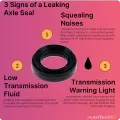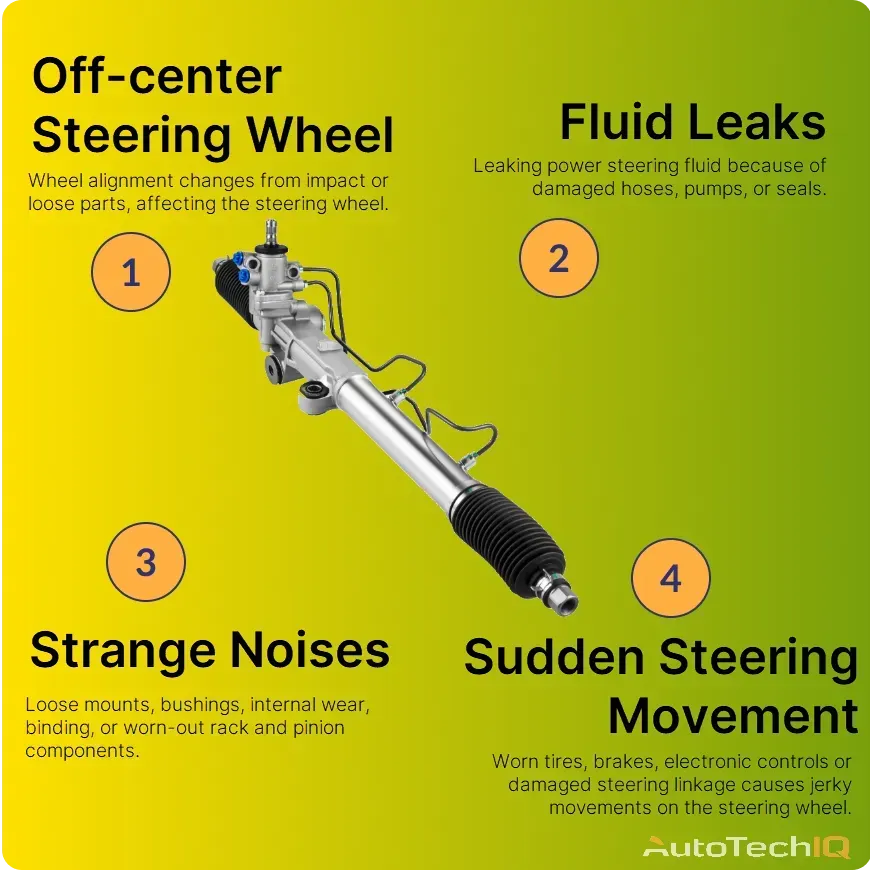
What is a rack and pinion?
A rack and pinion is a part of your car that’s connected to your steering wheel - it basically makes that when you turn the steering wheel, your vehicle’s wheels also turn.
In short, the rack and pinion steering happens because this component uses two items: a straight rack and a gear. The rack has teeth, and the gear rolls around them, moving from side to side.
How exactly does the rack and pinion steering work?
This rack/pinion system is under all the plastic and metal in your car, away from your vision, and it connects directly to your steering wheel. So, turning the steering wheel causes the rack and pinion to move "behind the curtains." The rack is actually connected to the wheels and the pinion, and the pinion is connected to the steering column (which is directly attached to the steering wheel). In a very rough summary, the movement goes like this: steering wheel - steering column - pinion - rack - wheels.
Various engineering systems beyond cars use rack-and-pinion principles, but you'll see it more popularly in vehicles because of how well they translate steering input into directional movement.
Can a bad rack and pinion cause shaking?
A bad rack and pinion can cause the vehicle to shake or vibrate. The rack and pinion connect directly to the steering system, so you might notice some shaking or vibration if they fail. The rack and pinion move the front wheels, so if they're faulty, the issue gets to the wheels, causing vibrations and making for an uncomfortable and potentially unsafe driving experience.
Is a rack and pinion hard to replace?
Yes. It has multiple steps like removing the front suspension components, disconnecting hydraulic lines, and precise alignment. It requires special tools and a good understanding of automotive systems. While it's not impossible for a skilled DIYer, it's best to go for a qualified mechanic to do this job. Note that this process is difficult and has potential safety risks if not done correctly.
Can a pothole damage the steering rack?
Yes. Potholes impact the front suspension and steering components. The steering rack gets these impact damages since it's part of the steering system. Consequently, the steering system gets misalignment, bent components, or internal damage to the rack and pinion. Therefore, it's best to check the steering system after hitting a big pothole to see if there's any damage.
How often does rack and pinion need to be replaced?
They can last 100,000 miles or more. In some cases, this part needs replacement due to wear and tear, damage from accidents, or manufacturer's recommendations. Typically, when symptoms like play in the steering, noise, or fluid leaks happen, you might have to plan a rack and pinion service. Regular maintenance and adherence to your vehicle's service schedule can help prolong the life of this component and ensure safe driving.
Can you still drive with a bad rack and pinion?
Yes, but it's dangerous. A bad rack and pinion create serious steering issues, and you might lose control of the car suddenly, risking an accident. Instead of driving with a faulty rack and pinion, consider having service. The risks of driving with this kind of steering problem involve a lot of extra expenses in the future.
What common issues can bad rack and pinion systems cause?
These are the most common issues drivers notice about a bad rack and pinion:
Steering Play: Excessive play or looseness in the steering wheel, where you turn the steering wheel but the vehicle takes too long to obey. This can make steering less precise and potentially dangerous.
Fluid Leaks: Visible power steering fluid leaks under the vehicle, and a low fluid level in the power steering reservoir. Leaks can occur from worn seals or damaged components within the rack and pinion, leading to reduced steering performance.
Strange Noises: Groaning, whining, or clunking noises when turning the steering wheel. These sounds often result from damaged or worn-out rack and pinion components.
Hard or Jerky Steering: The steering wheel becomes difficult to turn or experiences jerky movements. Typically, internal wear, binding, or misalignment of the pinion and rack causes this.
Steering Wheel Off-Center: If the steering wheel is off-center when driving straight, even after a wheel alignment. Internal problems may cause the rack to not return to its centered position.
Vibration or Shaking: A shaky or vibrating steering wheel, particularly at certain speeds. This can result in a lack of stability and safety concerns while driving.
Difficulty Maintaining a Straight Course: If the vehicle wanders or drifts unintentionally. Internal wear or misalignment may affect the vehicle's ability to maintain a straight trajectory.
These symptoms are essential indicators that the rack and pinion system requires attention and service.
How Top-tier Auto Repair Shops Perform a Rack and Pinion Service
To illustrate how a reliable auto shop deals with rack and pinion issues, we'll create an example. This example shows a fictional story, where the customer doesn't understand their car's issue, and the technical advisor uses transparency and teaching to complete the service.
Sarah, a car owner takes her car to Alex's auto shop complaining about steering issues, noises, and vibrations. Alex greets Sarah, asks for the symptoms she noticed, and starts inspecting.
Inspection: Alex checks the car's rack and pinion system. Alex raised the car on the lift and took photos of power steering fluid leaks that were coming from the steering rack. Sarah, the car owner, watches closely, wondering what's causing these problems.
Testing: Alex puts the car's steering system to the test. He turns the wheel, and he quickly spots a small delay; he also checks for movement on the steering system. There's also a faint noise when he does this. Sarah watches and notices these issues, but she doesn't know what's causing them.
Evaluation and Diagnosis: The signs are clear, but Sarah wants to know what's wrong. Alex organizes all the pictures he took and shows them to Sarah, pointing to the wear and leak signs. Then, Alex explains the causes for this, relating the issue to wear and tear; he also talks about how the car was acting during the tests and how its steering was bad. Sarah understands, and they agree to continue.
After removing the rack and pinion, Alex found more issues, including worn internal gears and housing damage. This evidence meant that a replacement was the only viable solution.
Confirming the Repair: Alex puts in a new rack and pinion unit and lines up the parts carefully. They take a test drive, and the steering feels smooth and works well. Sarah gets pictures showing the old and new units, which make it clear how the repair made a big difference. Sarah now understands the issue and why the replacement was necessary.
During this learning journey, Sarah not only sees what's happening but also learns about the repair and the problem it fixed, thanks to Alex's knowledge and straightforward explanations.

Through this educational journey, the car owner not only had their vehicle's issue resolved but also gained a deep appreciation for the process, thanks to Alex's expertise and commitment to transparency.
The Most Common 5 Causes for Pinion and Rack Issues
Seal and Gasket Failure: When seals or gaskets within the rack and pinion assembly degrade, they allow power steering fluid to leak, leading to diminished performance and fluid loss.
Contamination: The intrusion of contaminants or debris into the power steering system can damage internal components, causing erratic steering behavior and noise.
Wear and Tear: Normal wear over time, including gear wear and housing damage, can result in play in the steering, noise, and fluid leaks, ultimately causing symptoms of a bad rack and pinion.
Improper Maintenance: Neglecting routine power steering fluid changes and maintenance can lead to fluid breakdown and debris accumulation, contributing to internal damage in the rack and pinion.
External Damage: Physical damage from accidents, road hazards, or hitting potholes can directly impact the rack and pinion, causing misalignment, housing damage, and fluid leaks, resulting in steering symptoms.
The Main Fixes for a Rack and Pinion Issue
Rack and Pinion Replacement: The worn or damaged rack and pinion assembly is swapped with a new unit, restoring proper steering functionality and eliminating associated symptoms.
Inner tie rod replacement: The inner tie rod comes with a new rack and pinion and is replaceable separately. Sometimes, the inner tie rod is the only thing that is damaged or worn, and replacing it restores the rack to function safely and properly.
Seal and Gasket Replacement: Addressing leaks, damaged seals, or gaskets are replaced to prevent power steering fluid loss and maintain steering performance.
Flushing and Replacing Power Steering Fluid: Regular fluid changes help remove contaminants, extending the life of the rack and pinion and maintaining smooth steering.
Power Steering System Flushing: A comprehensive flushing of the entire power steering system removes contaminants, ensuring optimal performance and preventing future rack and pinion issues.
Alignment and Suspension Repairs: Correcting wheel alignment and addressing suspension issues ensures that the rack and pinion operate in the ideal conditions, eliminating steering symptoms.
Frequently Asked Questions
1. What is a rack and pinion?
A rack and pinion is a car part that makes your vehicle’s wheels turn in the same direction you turn the steering wheel. It works by using a small gear (pinion) that moves a long, straight gear (rack) to the side the steering wheel is turning to, making your wheels also turn.
2. How does rack and pinion steering work?
When you turn the steering wheel, it moves the pinion gear, which pushes the rack either left or right, depending on the direction you turn the steering wheel. This movement is sent to the tie rods and wheels, making the car turn in the direction you want.
3. What are the symptoms of a bad rack and pinion?
If your rack and pinion steering is failing, you might notice:
-
Steering feels loose or has too much play
-
Hard to turn the wheel, especially at low speeds
-
Steering wheel shakes when driving
-
Grinding or clunking noises when turning
-
Leaking power steering fluid (you might see red or brown fluid under the car)
-
Uneven tire wear, meaning one side of your tires wears out faster
4. Can I drive with a bad rack and pinion?
Technically, yes—but it’s not safe. A failing rack pinion can make it difficult to control the car, risking total control loss at sudden, unexpected times. If you notice bad rack and pinion symptoms, get it checked ASAP.
6. How long does a rack and pinion last?
A rack pinion system usually lasts 100,000 to 150,000 miles, but it depends on your driving conditions. Potholes, rough roads, and aggressive driving can wear it out faster.
7. Can I fix a bad rack and pinion myself?
If you’re experienced with car repairs, you can try, but it’s a complicated job that might damage other parts of your vehicle. You’ll need to:
-
Remove the old rack
-
Replace it with a new one
-
Reconnect the tie rods and power steering hoses
-
Refill and bleed the power steering fluid
-
Get a wheel alignment afterward
It’s always better to let a mechanic handle it with professional tools.
8. What causes a rack and pinion to go bad?
-
Normal wear and tear over time
-
Power steering fluid leaks, causing low fluid levels
-
Hitting potholes or curbs too hard
-
Lack of maintenance (not checking or replacing power steering fluid)
9. How do I know if my power steering problem is from the rack and pinion?
If you’re having steering issues, check these signs:
-
Whining or groaning noise? Could be low power steering fluid.
-
Fluid leaking from under the car? Might be a bad rack and pinion or a leaking hose.
-
Steering feels stiff or unresponsive? Could be a rack and pinion issue or failing power steering pump.
Summary
In this article, we talked about how rack and pinion systems operate, explaining their role in vehicle steering. We detailed the typical symptoms of rack and pinion issues, clarified the diagnostic process, and narrated a fictional scenario through inspection, testing, diagnosis, and repair confirmation. Further, we explained the leading root causes of rack and pinion issues and proposed effective fixes for each. This whole essay offers invaluable insights into this vital automotive component.
There's an auto shop near you delivering fair, transparent service like you've read here.
Feel free to visit our 'Shop Near You' page and search for our certified repair shops in your area. These businesses provide top-notch services while also offering expert inspections using advanced diagnostic tools. You'll witness the same level of care and attention to detail that we've highlighted in this article. These shops share our goal of ensuring that your vehicle receives the best possible maintenance. At this goal's core, your knowledge of what's happening to your car and how to maintain it is our #1 priority.
Other news
-
Car is Squealing When Driving
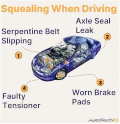
-
What is Preventative Maintenance and What Are The Benefits of it?

-
JobViewIQ - DVI Process Training - Part of the Auto Care Alliance Benefits

-
7 Signs of AC Pulley Issues
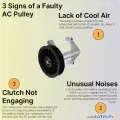
-
7 Signs of Clogged AC Components
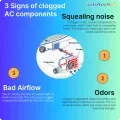
-
How Much Does a Transmission Fluid Change Cost?
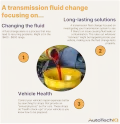
-
7 Signs of a Leaking Axle Seal
